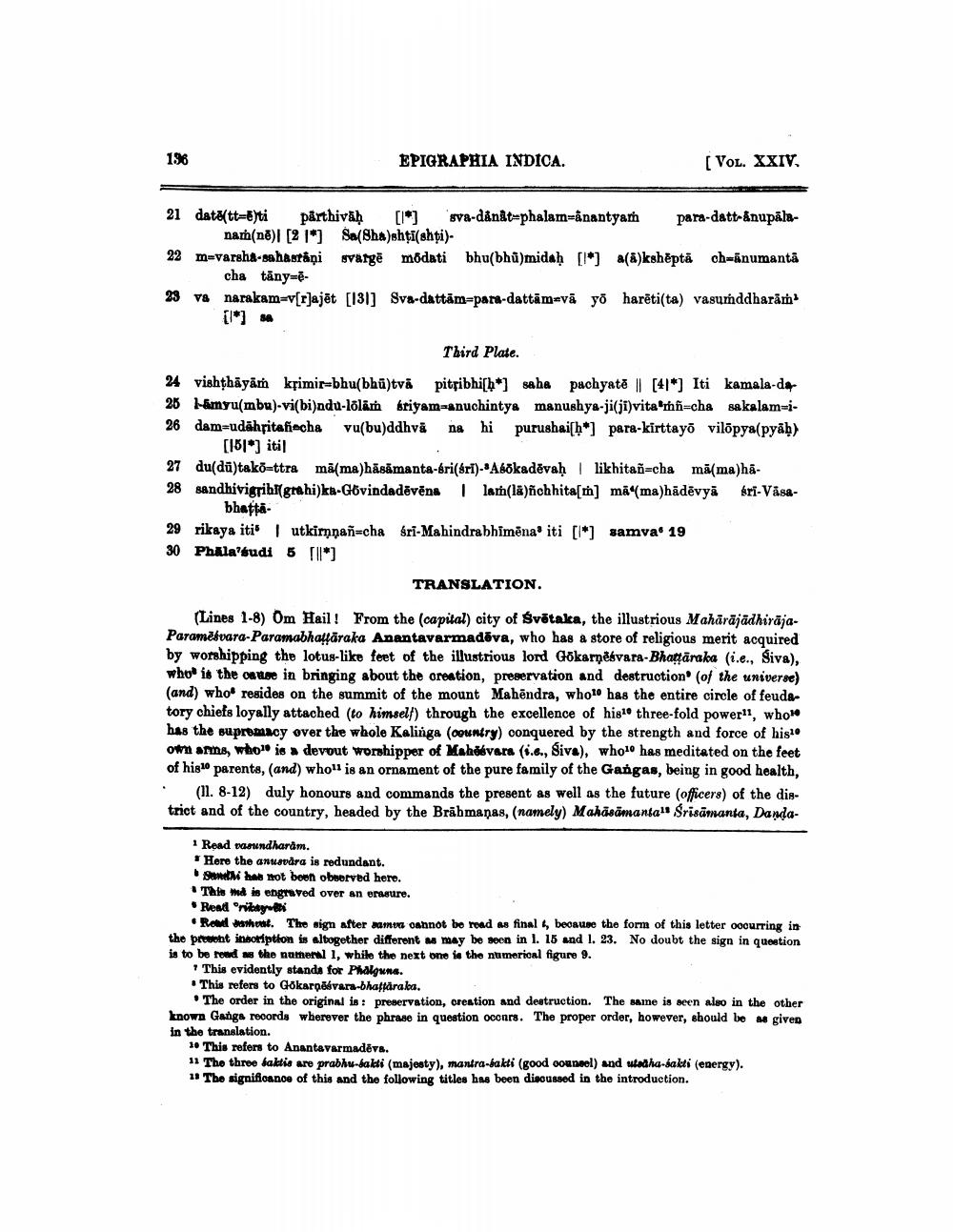________________
136
EPIGRAPHIA INDICA.
[Vol. XXIV,
21 date(tt-Eti parthivaḥ [1] Sva-dånåt=phalamanantyam para-datt-&nupala
nam(nő) [2 1*) Ša(She)shți(shți). 22 m=varsha-sahastaņi gvargë módati bhu(bhū)midaḥ [l*) a(a)kshēptā ch=anumantă
cha tänyre23 va narakam=v[1]ajēt [131] Sva-dattām-para-dattām vā yo harēti(ta) vasurddharām
Third Plate.
24 vishthāyām krimir-bhubhūytvä pitsibhish*] saha pachyata || [41*] Iti kamala-da 28 l-amyu/mbu)-vi(bi)ndu-lolär briyam-anuchintya manushya-ji(i)vita'mn=cha sakalam=i26 dam=udāhfitafiecha vu(bu)ddhvá na hi purushai[h*) para-kirttayo vilõpya(pyāḥ)
[181*) iti! 27 du(dū)tako=ttra mä(ma)hăsămanta-bri(Sri)-Abokadēvaḥ likhitañ=cha mā(ma)ha28 sandhivigrihf(grahi)ka-Govindadēvēns | lam(la)ñchhita[m] mā"(ma)hādēvya sri-Väsa
bhatta29 rikaya iti | utkimnan=cha Sri-Mahindrabhimēna iti [l*] samva. 19 30 Phala'sudi 5
TRANSLATION.
(Lines 1-8) Om Hail! From the capital) city of Svõtaka, the illustrious MahäräjädhirajaParamèsvara-Paramabhaffäraka Anantavarmadēva, who has a store of religious merit acquired by worshipping the lotus-like feet of the illustrious lord Gokarnesvara-Bhattāraka (i.e., Siva), who is the ones in bringing about the creation, preservation and destruction of the universe) (and) who resides on the summit of the mount Mahēndra, whole has the entire circle of feudatory chiefs loyally attached (to himself) through the excellence of his three-fold power, who has the supremacy over the whole Kalinga (country) conquered by the strength and force of hisle of arms, who is a devout worshipper of Mahesvars (i..., Siva), whole has meditated on the feet of his parents, (and) who is an ornament of the pure family of the Gangas, being in good health,
(11. 8-12) duly honours and commands the present as well as the future officers) of the district and of the country, headed by the Brābmaņas, (namely) Mahasamantal frisämanta, Danda
Read vasundharam. Here the anusvåra is redundant. S M has not been obwerved here.
This id is engraved over an erasure. . Read Onibaguhi
• Rodehot. The sign after namna cannot be read as finally because the form of this letter occurring in the present inscription is altogether different ms may be seen in l. 15 and 1. 23. No doubt the sign in question is to be read as the numer 1, while the next one is the numerical figure 9.
+ This evidently stands for Phalguns. . This refers to Gokarpara-bhaffaraba.
• The order in the original is : preservation, creation and destruction. The same is seen also in the other known Gangs records wherever the phrase in question occars. The proper order, however, should be a given in the translation.
1. This refers to Anantavarmadēvs. 11 The three faktis are prabhu-bakti (majesty), mantra-baldi (good couneel) and wedha-sakti (energy). 11 The significance of this and the following titles has been discussed in the introduction.




